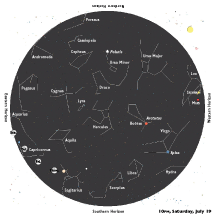Sky Watch by J. Alex Knoll
Thunder in the Sky
July’s full moon and Arcturus in the west foretell storms
The sun sets in the northwest July 17 at 8:30 as July’s full Buck Moon rises in the southeast. This is the time of year when a male deer’s new set of velvety-soft antlers sprout. Across the great plains, Native Americans like the Cherokee called this the Ripe Corn Moon; other tribes called it the Thunder Moon, the Corn Moon the Hay Moon or the Ripe Cherry Moon. In medieval Europe, it was the Mead Moon.
One of the most recognizable stars, though far from brightest, is the North Star Polaris of Ursa Minor, the little bear, more commonly called the Little Dipper. Hour by hour, night by night, month after month, Polaris stands stationary while the rest of the celestial lights, even its own constellation, pivot counter-clockwise.
Standing beside the little bear is its mother, Ursa Major, easily recognized as the Big Dipper. From the Dipper’s handle, arc to the bear-keeper Arcturus, the brightest star in the Northern Hemisphere.
At 11pm, this orange-red giant shines due west. Like July’s full moon, Arcturus shining high in the west this time of year presages violent thunderstorms. Twenty-five times the size of our sun and 37 light years from earth, Arcturus is close by stellar standards. But, in fact, it is flying away from us at more than 300,000 miles an hour. Arcturus’ motion, in fact, first led astronomers to suspect that the universe is expanding. In 500,000 years the star will be gone from our night sky.
From Arcturus, spike south to Spica, the blue-white giant of Virgo. The 16th-brightest star, Spica is one of the hottest, more than 13,000 times hotter than our sun. Much of Spica’s luminosity, however, is in the ultraviolet spectrum, thus invisible to us; otherwise this beast would outshine all other stars.
Tidelog®
Illustration: © Copyright 1925 M.C. Escher/Cordon Art-Baarn-Holland; Graphics: © Copyright 2007 Pacific Publishers. Reprinted by permission from the Tidelog graphic almanac. Bound copies of the annual Tidelog for Chesapeake Bay are $14.95 ppd. from Pacific Publishers, Box 480, Bolinas, CA 94924. Phone 415-868-2909. Weather affects tides. This information is believed to be reliable but no guarantee of accuracy is made by Bay Weekly or Pacific Publishers. The actual layout of Tidelog differs from that used in Bay Weekly. Tidelog graphics are repositioned to reflect Bay Weekly’s distribution cycle.Tides are based on National Oceanic and Atmospheric Administration and are positioned to coincide with high and low tides of Tidelog.
